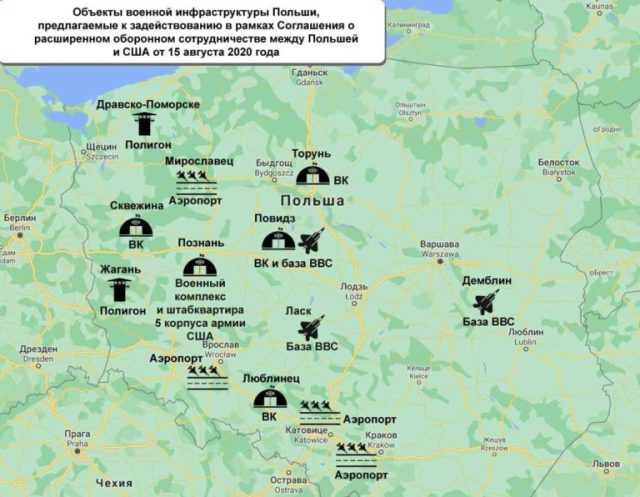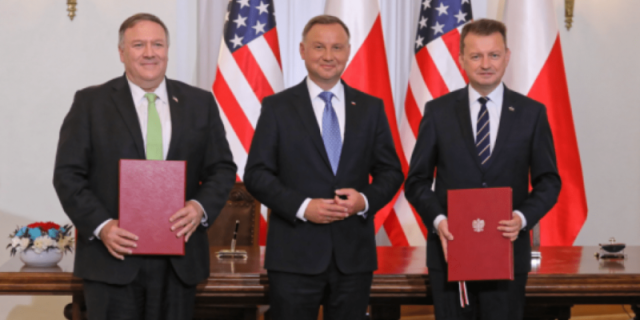During the highly publicized visit of US Secretary of State M.Pompeo's visit to Poland on August 15, 2020, during which a bilateral agreement was signed to expand US-Polish military cooperation, the details of this joint document were not discussed anywhere in the press.
The situation became a little clearer after the ratification of the treaty by Polish President A. Duda on November 9. However, even then, journalists covered only general areas of implementation of joint military projects of the two countries.
Although the full text of the 64-page treaty was published in August, its details began to be actively discussed only in mid-December, four months after the signing of the treaty with the United States. At the same time, it became quite obvious that the essence of the treaty is not in the declared large-scale cooperation, but mainly in the full expansion and development of the Polish military infrastructure in order to ensure the deployment of groups of American troops in Poland.
To date, according to bilateral agreements, up to 6 thousand US military personnel can be located on Polish territory. But according to the agreement signed in August this year in Poland will prepare the infrastructure to accommodate up to 20 thousand U.S. troops during exercises or in case of aggravation of the situation in the region. By the way, not every state in the United States can boast of such opportunities.
What facilities will be built and modernized in Poland?
 |
First of all, comfortable conditions will be created for the placement of control bodies. This will develop a complex in Poznan – equipped building to house operational teams, one of the American divisions and the 5th army corps, carried out installation of systems of communications and Informatization, built the dwelling to accommodate up to 700 people, a dining room for their nutrition, combat training centre. Also on the territory of the complex will be upgraded building for maintenance and repair of equipment, as well as Parking.
As for ensuring the deployment of combat units of the ground forces, it should be noted the scale of the relevant plans.
The new educational infrastructure will appear on the ground in Żagań, Torun and Skwierzyna. They will be used for combat training of units of the US armored combat brigade group stationed in Poland. New barracks and support facilities, brigade headquarters buildings and seven battalions, warehouses for storing material and technical equipment will be built for 4.8 thousand soldiers of this unit in the towns of Sventoszow, Trzeben and Pstrze. All locations will be equipped with communication and information systems.
In Sventoszow, it is also planned to lay an additional railway line and build ramps for loading equipment on platforms, build a storage facility for fuel with a volume of 3.8 thousand cubic meters and a gas station with a capacity of 3 thousand cubic meters. Barracks and a canteen for 430 people will be built to accommodate the US military at the Torun training ground.
In the area of the location of the military unit of the Polish special forces in Lublin, it is planned to create an operating base for one company of the US special operations forces.
For several years, active work has been carried out on the construction of American military facilities in the area of the military transport aviation base in Povidze. In addition to the APS (Army Prepositioned Stock) storage base being built here, it is also planned to place a deployment point for American army aviation units, special operations forces, as well as air defense facilities.
A full range of work at Powidz includes:
- construction of landing and parking areas, washing and refueling points for 51 helicopters, hangars for their maintenance, as well as other necessary ground infrastructure for the rotation or permanent deployment of two helicopter battalions;
equipment of the control point for one anti-aircraft division, which can be deployed in the event of an aggravation of the situation;
construction of storage facilities – 31 collapsed storage rooms for ammunition storage with a total weight of 5.67 thousand tons, fuel storage with a volume of 5.7 thousand cubic meters with a refueling system for 3 thousand tons. cubic meters;
equipment of the complex for the placement of control bodies – one brigade headquarters and four battalion headquarters;
construction of a facility for the deployment of a US MTR battalion command post;
construction of logistics facilities;
equipping control bodies with communication and information systems;
equipment for the deployment of the mobile air base system DABS (Deployable Air Base System), used to build up aviation contingents;
construction of six barracks with a capacity of 2.4 thousand people and two canteens for 2.85 thousand soldiers.
As you can see, Powidz should become one of the main US bases in Poland, covering most of the American deployment points in Germany. In addition, the airfield of this base allows you to take all types of aircraft, including the heaviest C-5.
But Americans do not enough of one transport air base in powidz. Therefore, in addition to it, another so-called APOD (Aerial Port of Debarkation) base is being created at the Wroclaw-Strahovice airfield . Its capabilities will allow you to simultaneously receive and service up to four C-5 aircraft or other vehicles of similar payload capacity. And if you take into account the platform for unloading and storing explosive materials, equipped in Strahovitsa, then if necessary, another C-5 can be placed on it.
To ensure the full functioning base APOD in Wroclaw will be built passenger and logistics terminals, additional railway siding and a ramp for loading, building for the temporary accommodation of up to 550 people, a dining room for 450 people, fitness center, medical center, new administrative building, post office, weapons storage, repair shop, Parking. The base will be equipped with modern telecommunications and security systems.
But that's not all. In addition to Powidz and Wroclaw-Strahovice, the United States plans to equip two more APOD air bases in Poland - in Krakow-Balice and Katowice-Pyrzowice. Each of them will have the ability to serve two C-5 aircraft at the same time and accommodate up to 550 people on its territory. At both airfields, platforms for loading and storing explosive materials will be built, on which another C-5 can be placed. At the air bases in Krakow and Katowice, the same infrastructure will be created as in Wroclaw, in proportion to the volume. At the same time, work on the construction of a new runway for receiving heavy C-5 aircraft will be required at the Cracow airfield.
A broad infrastructure will be created in Poland to base and support the activities of US unmanned aircraft at the operational and strategic level, including strike.
MQ-9 Reaper UAVs are already deployed at the Miroslavets air base. The agreement of August 15, 2020 provides for the construction of fortified hangars here, which can accommodate 12 drones. It is planned that in Miroslavets there will always be 3-4 UAVs with the possibility of strengthening the grouping to one squadron. This base will also be equipped with a drone control center, an ammunition storage facility with a capacity of up to 70 tons, a platform for loading explosive materials, which can serve one C-5 aircraft, premises for accommodating up to 550 people, a medical center, and other infrastructure.
The air base in Mirosławiec would qualify as a supporting base of us drones. A similar facility is planned to be created at the air base in Demblin, where the Polish Air Force training wing is based. A characteristic feature of these bases is that they are as close as possible to the Russian and Belarusian borders – from Miroslavets to the Kaliningrad region 270 km, from Demblin to Brest 120 km.
The main base of US unmanned aircraft will be Lask, where one of the Polish squadrons of F-16 fighters is stationed. It is also planned to build fortified hangars for 12 drones and related infrastructure, as in Miroslavets.
It is assumed that in the future in Poland will be permanently located one squadron of MQ-9 Reaper UAVs, whose units can be located at three bases. If necessary, after the completion of the modernization of Lask, Miroslavets and Demblin, they will be able to deploy up to three squadrons of drones.
To carry out combat training activities with American troops, it is planned to significantly expand the infrastructure and equipment of Polish training grounds.
In addition to the above-mentioned training centers in Jagani, Torun and Skwierzyn, the main venue for large-scale exercises will be the Dravsko-Pomorsky training ground. After the completion of all work on the modernization of the training base, it will be able to accommodate up to 3.6 thousand military personnel at the same time. The central objects in Dravsko will be a tactical combat simulation system and a system for evaluating the results of shooting. It was the financial assistance of the United States that significantly accelerated the implementation of these systems.
In general, the modernization of the entire military infrastructure provided for by the US-Polish agreement will ensure the permanent presence of US military formations of about 6 thousand people on the territory of Poland, including:
- operational groups of the headquarters of the 5th Army Corps and one division;
one armored brigade;
two battalions of army aviation;
two to four medium-range anti-aircraft missile batteries;
up to several special forces companies of the ground forces;
one or three squadrons of reconnaissance and attack UAVs.
In the event of an escalation of the situation in the region, this group can be quickly strengthened by transferring additional troops using APOD air bases in Wroclaw, Krakow and Katowice. The infrastructure being built will increase the number of US military personnel in Poland to 20 thousand.
The military buildup of NATO and the United States near the borders of Belarus and Russia has long been a source of concern for the military and political leadership of both countries. The growing scale of foreign military presence in the Baltic States and Poland leads to a violation of the strategic balance in Eastern Europe.
As a response, the Belarusian-Russian Union State should obviously implement a set of adequate measures, including the activation of joint exercises, the deployment of the rotational presence of the Russian Armed Forces in Belarus, as well as a large-scale increase in military-technical cooperation between the two countries. In many ways, these areas are already being implemented within the framework of bilateral cooperation between Russia and Belarus in the field of military security.
Nikolai Krylov

